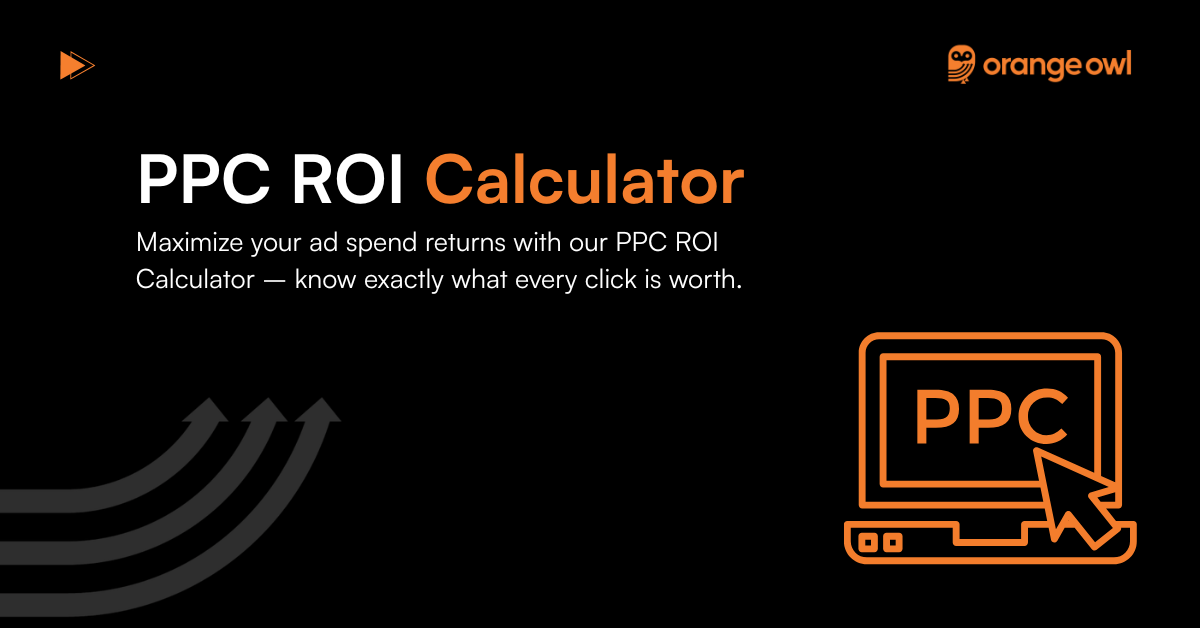PPC ROI Calculator

Table of Contents
What is PPC ROI?
PPC ROI (Pay-Per-Click Return on Investment) is the most important metric that tells you if your ad spend is truly generating profits. While impressions and clicks show visibility, ROI directly measures whether your campaigns are adding to your bottom line.
In simple terms, PPC ROI answers the question:
👉 “For every rupee I spend on ads, how much do I get back in return?”
For example, if you spend ₹10,000 on a Google Ads campaign and generate ₹30,000 in revenue, your PPC ROI is 200%. That means every ₹1 you spent brought back ₹2 in profit. In fact, companies make an average of $2 for every $1 spent on Google Ads, according to this Economic Impact Report—showing just how powerful PPC can be when executed strategically.
How to Calculate PPC ROI
The formula is straightforward:
PPC ROI = (Revenue from PPC – Cost of PPC) ÷ Cost of PPC × 100
 Example:
Example:
- Total Ad Spend: ₹20,000
- Revenue Generated: ₹50,000
PPC ROI = (50,000 – 20,000) ÷ 20,000 × 100 = 150% ROI
That means you earned ₹1.5 in profit for every ₹1 you spent on ads.
Just like with CPA, you can calculate PPC ROI across campaigns, platforms, or timeframes to understand which channel delivers the best return.
What’s a Good PPC ROI?
There isn’t a single “good” PPC ROI — it depends on your business model, industry margins, and customer lifetime value (LTV). But here are some general benchmarks:
- E-commerce businesses often target 200–300% ROI (2–3x returns).
- SaaS companies may be okay with a lower short-term ROI if it means acquiring long-term recurring revenue.
- Startups might accept breakeven ROI in the early stages if it fuels growth and market penetration.
💡 Rule of thumb: If your ROI is consistently above 100%, you’re profitable. The higher the number, the more efficient your campaigns are.
Why PPC ROI Matters
ROI is the ultimate health check for your ad campaigns. It helps you:
✅ See which campaigns generate real profits
✅ Justify ad spend to stakeholders and leadership
✅ Allocate budgets to the best-performing channels
✅ Identify wasteful campaigns draining your budget
✅ Build sustainable, scalable growth
Without ROI tracking, you could be wasting money on campaigns that “look good” but don’t actually bring in revenue.
Metrics That Impact PPC ROI
Your PPC ROI is influenced by multiple factors across the funnel:
- Click-Through Rate (CTR): More clicks at lower costs = better ROI
- Conversion Rate (CR): Higher conversions boost revenue
- Average Order Value (AOV): Larger purchases improve returns
- Cost Per Click (CPC): Lower CPC reduces ad spend burden
- Customer Lifetime Value (LTV): High-LTV customers make campaigns more profitable
If any of these metrics drop, your ROI will suffer.
What Can Reduce Your PPC ROI?
If your ROI is lower than expected, it could be due to:
- Rising competition is driving up CPCs
- Low-quality leads that don’t convert
- Poorly optimised landing pages
- Wrong audience targeting
- High churn or low repeat purchase rates
- Weak tracking setup (incomplete data)
Often, the issue isn’t just in ads but in the post-click funnel—the journey after a customer clicks.
How Marketers Use PPC ROI
Marketers, founders, and growth teams rely on ROI as the north star metric for PPC. They use it to:
- Compare performance across ad platforms (Google, Meta, LinkedIn)
- Set budget allocation strategies
- Decide which campaigns to scale or pause
- Align marketing efforts with financial goals
- Validate whether a channel has long-term profitability
Using a PPC ROI Calculator
Instead of crunching numbers manually, a PPC ROI Calculator does the math instantly.
Just enter:
- Your total ad spend
- Your total revenue generated
And instantly see your PPC ROI in percentage terms. This makes it easy to compare across periods, campaigns, or channels.
How to Improve PPC ROI
Boosting ROI isn’t just about cutting costs — it’s about maximising revenue from each click. Here’s how:
- Refine targeting → Focus on high-intent audiences
- Improve ad copy & creatives → Drive higher engagement
- Optimise landing pages → Faster load times + better UX = more conversions
- Leverage retargeting → Recover lost prospects
- Test bidding strategies → Smart bidding can lower CPCs
- Increase AOV → Upsells, bundles, and discounts improve returns
Remember: Even a small increase in conversion rate or AOV can dramatically improve ROI.
When Should You Track PPC ROI?
You should monitor ROI consistently, but it’s especially important when:
- Running high-budget campaigns
- Scaling ad spend into new markets
- Comparing multiple ad platforms
- Reporting results to investors or stakeholders
- Auditing funnel performance
How Orange Owl Helps You Improve ROI
At Orange Owl, we help startups and growth teams maximise their PPC ROI. From advanced keyword strategies and data-driven targeting to ad creative testing and funnel optimisation — we fine-tune every step of your campaigns.
Because it’s not about clicks or impressions — it’s about profitable growth.
Frequently Asked Questions (FAQs) on PPC ROI
While ROI varies by industry, small businesses generally aim for a 200–300% return on their ad spend, meaning $2–$3 earned for every $1 spent.
It’s best to track PPC ROI weekly for campaigns with high spend, but monthly analysis helps identify long-term trends.
Improving targeting, writing stronger ad copy, optimizing landing pages, and using negative keywords are cost-efficient ways to maximize ROI.
Yes. Google Ads usually drives intent-based conversions, while Meta Ads often excels in awareness and audience building, so ROI benchmarks vary.
Yes, factoring in LTV gives a more realistic ROI picture, especially for subscription or repeat-purchase businesses.
Yes. AI-powered bidding, predictive targeting, and automated ad optimization can significantly boost ROI by reducing wasted spend.
